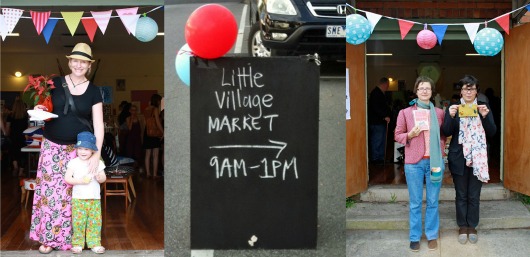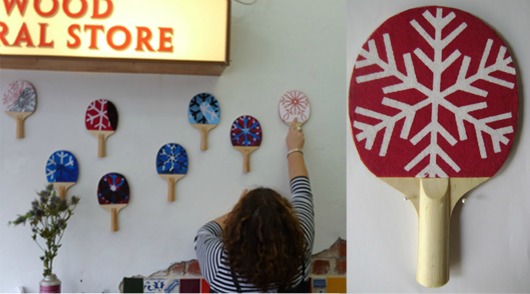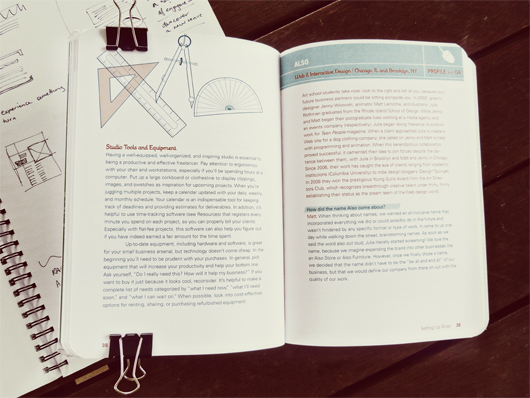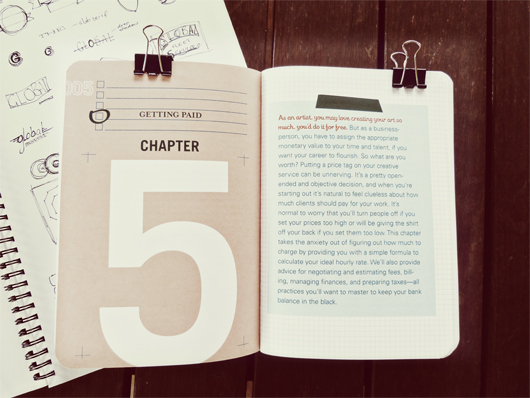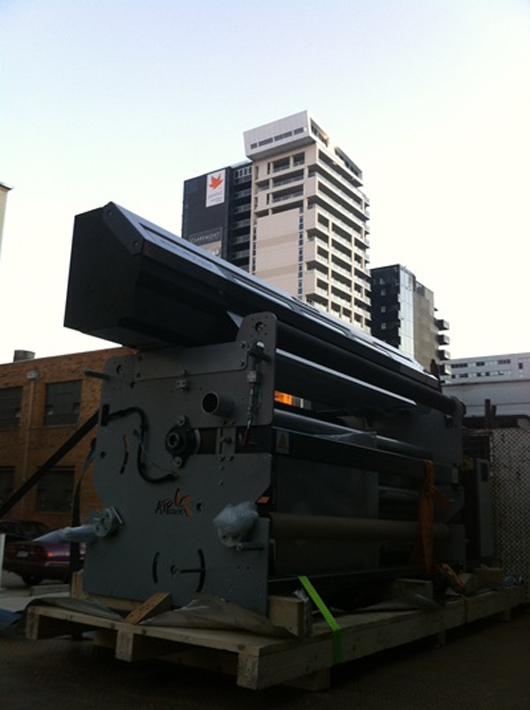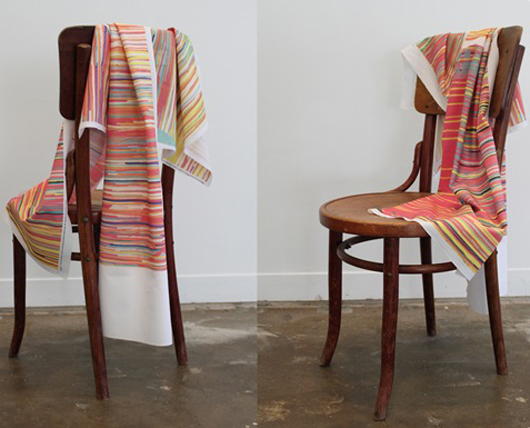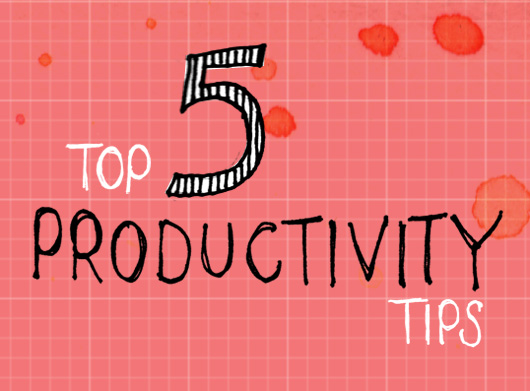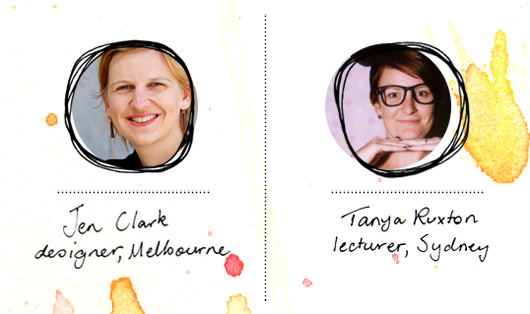Eco-Friendly Practice: Hayley Morris
By Phoebe Miller This month's eco-friendly profile takes a slightly different turn. In our first few posts, we've focused on creative ladies who operate product-focused creative practices. However, I wanted to acknowledge that there are a lot of creative women out there who are doing other work relating to environmental sustainability that involves a great deal of creativity.
Enter Hayley Morris: Founding Director of Sustainable Table, an environmental not-for-profit organisation based in Melbourne that uses food as an entree to explore sustainability issues and support environmental projects in developing communities.
You may have already heard of The Sustainable Table Cookbook, a collection of recipes and stories from notable chefs, farmers, producers, winemakers, gardeners and everyday people who are reducing their impact on the environment by altering their food choices. As I discovered in doing this interview, there's a lot more to learn from and be inspired by in Hayley's work than just delicious recipes.
What do you do? I work on two enterprises, one a not-for-profit (Sustainable Table) and the other for-profit social enterprise (Impact Sustainability).
Sustainable Table is a young, innovative organisation that empowers individuals to use their shopping dollar as a vote for a food system that is fair, healthy, humane and good for the environment. We do this by providing knowledge and resources, run innovative and challenging events and harness the media and social media platforms to assist individuals to make conscious decisions about where they shop and what they buy.
We also acknowledge how lucky we are to be living in a country that is generally food secure, so we 'give back' by supporting projects in developing communities that assist with the food security of the community. Projects include building compost toilets in Kenya that improve local, small-scale farming as well as provide basic sanitation in a region where water borne diseases are rift; solar cookers for Tibetan Villages in China; and micro finance to support the development of small-scale agricultural projects in Kenya.
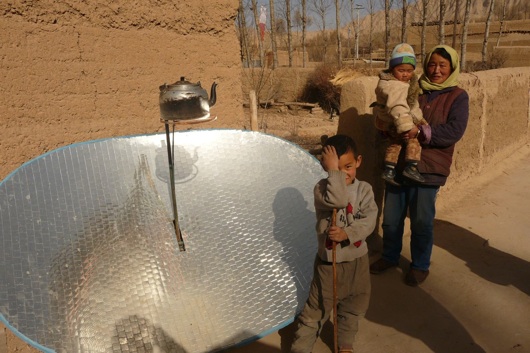 Sustainable Table's solar cooker project
Sustainable Table's solar cooker project
Impact Sustainability supports businesses to better understand their environmental impact via an affordable and easy-to-use online tool, Impact Management System (IMS).
The system was developed after I had spent time consulting to help companies understand their environmental footprint and ways to reduce it. It was clear that all businesses would find it hard to continue to maintain the actions they had started and improve on their environmental performance if they didn't have a system to help support this process. After all, 'what get's measured, get's managed'.
A market scan showed that the systems on offer were complex and expensive, targeting large companies with complex greenhouse gas emission portfolios. With IMS I wanted to create a system that was simple and affordable and benefited the environment as more companies could afford to take action. In addition a percentage of revenue would be used to support Sustainable Table.
How do you approach sustainability and environmental awareness in your work? We use creative and innovative ideas to educate and empowering individuals and companies to act more environmentally sustainable. We have a strong focus on design, marketing and communications as a way to engage people. I believe this is a real point of difference for Sustainable Table and I think it’s why people have been really engaged with our work.
The Sustainable Table cookbook
Can you tell us about your favourite project to date? The Sustainable Table cookbook is definitely a key project where design and creativity was key in creating a successful book. Our challenge was to try and get people who don’t normally care about the environment to pick up the book, buy it and then learn something about how they can make a difference. In order to ‘hook’ people in we knew we needed the book to look beautiful and work as a functional cookbook. The first edition won Australian printed book of the year, so some people must think we did a good job!
 Internal layouts from The Sustainable Table cookbook
Internal layouts from The Sustainable Table cookbook
Innovative events also form a big part of your work. What events have you held recently? Our Melbourne Food and Wine Festival sell-out event in March, hosted at the Robert Burns Hotel in Collingwood, set to challenge guests with the reality of how meat ends up on their plate. With most Australians eating roughly their own weight in meat each year (80kg) and with more than 500 million animals housed in factory farms, the aim was to raise awareness around the environmental and ethical issues surrounding meat production in Australia, whilst contrasting that with dining on wild rabbit. The event was profiled on ABC’s 7.30 Report and in Broadsheet.
In February this year, we held an event as part of the Sustainable Living Festival. A Dirty Granny Jamming Session was all about preserving excess produce. What do the granny skills of the past have to do with the way of the future? If there's one thing all grannies are good at, it's this - preserving, jamming and bottling excess produce to avoid food waste. These vintage kitchen skills have seen a resurgence in recent times, and their importance cannot be underestimated given Australians throw out $5.2 billion worth of food each year. Our event set to educate people on food waste and provide them with a set of Staples from Scratch recipes to kick-start their zero-waste enthusiasm.
What challenges have you come up against in trying to make your work more sustainable and how did you overcome them? There is definitely a higher cost in making things sustainable, for example we were faced with the question of lowering our printing costs of The Sustainable Table cookbook significantly by printing the book in China, therefore increasing our margins. However it was important to us and the ethos of the book to ensure it was printed locally, on 100% recycled paper and by printing standards that have the least impact on the environment.
Are you inspired by any other creative women? Probably my colleague Cassie Duncan. She is so passionate, creative and inspiring - she is the real heart behind Sustainable Table.
Phoebe Miller is a Brisbane-bred, Sydney-fled, Melbourne-embedded gal who enjoys making, spruiking, collecting, exploring, telling her friends where to eat and posting photos of doors on instagram. After several years working in corporate marketing and communications, Phoebe followed the urge to explore her creative side. These days she divides her time between her sustainable fashion accessories label, Simply Phoebe, and freelance PR consulting.
Featured Member Interview: Bella Cooke
Are you after something with a distinctly Melbourne feel to decorate your space? Or are you wanting great day out at a fabulous market, Bella Cooke from Make Merry has you covered! Welcome Bella as our featured member on the CWC blog this month.

What do you create? Currently in the studio my work is print based either in the form of home ware textiles or travel inspired posters. Out of the studio I created and run two craft and vintage focused markets: The Little Village Market in Elwood and the Bank Street Market in South Melbourne.
Have you done training in your creative field or has it come about informally? I have always considered myself a Jill-of-all-trades when it comes to all things creative. Even though I have a background and formal training in Fine and Visual Arts I have always felt more comfortable in Camp Craft and as such have embraced all things handmade with a design focus. Informally I learnt how to organize events and corral large groups of people after being a Secondary Teacher for many years. Nothing like a 4-day hike in the bush with a group of unpredictable teenagers girls to teach you how to improvise, make do and make it home alive!
What are your main creative inspirations? Colour, pattern, flowers, textures and typography. I am also inspired by the hard work and risks other creative’s take, as they spur me on to be bold and brave.
How do you balance your creative projects with the administration aspect of your creative work? Lists, lists and more lists! It has taken me a while to be one of those "organised people" and now I am able to keep track of what projects I have on the boil without losing my cool or bursting into tears in front of the sales guy at Office Works! Sporty Spice I am not, but being able to keep all my balls in the air and having a spare hand to pick up another project is like an adrenalin sport for me and I thrive on it. I am at my happiest when I am flat strap and as busy as hell, but find that my best work emerges under the greatest pressure as I simply don't have time to contemplate it for too long.
What do you do when you experience a creative block? Am not proud to say it, but I am an incredibly impatient person. When I find myself stumbling around an idea and becoming frustrated, time is of the essence to clear the blockage and I will either hit the streets with my camera, race off to the nearest flea market or do random image searches on the internet. All it takes is a great colour combination or a beautiful texture to jolt me back into action and feeling spirited again. My more guilty creative pleasure is escaping into the world of pay-tv that we got rigged up at home last year. Television may be the opiate of the masses but who can resist the endless design, travel and cooking shows that whisk me away from my couch in Elwood to the streets of New York or to a two donkey village in Mexico? The cable that runs from the back of our set, through the wall and up to the satellite dish on the roof is my lifeline to faraway lands.
What future goals do you have for your creative pursuits? Ideally I would like to develop Make Merry and all it encompasses into being more than a "hobby that pays" into a grown up girls business all of my own. I am having so much fun with running the markets and producing items for Make Merry at Home that I am creatively content with the goals being kicked at the moment.
Thanks for sharing your creativity today Bella! You can find out more about Bella & Make Merry here: Shop: www.makemerry.bigcartel.com Website: www.bellacooke.com
Roslyn Russell is a sewist, blogger and teacher. Her blog, Sew Delicious, is where she showcases her latest projects, designs and sewing tutorials. Roslyn also enjoys cake baking and decorating, exploring Melbourne cafes and restaurants, and hunting through op-shops for vintage sewing and kitchen treasures.
Organise Me: Creative, Inc Review
Creative, Inc The Ultimate Guide to Running a Successful Freelance Business
Creative, Inc is a little how to guide for freelancers, written by two knowledgeable freelance creatives Meg Mateo Ilasco author of Craft, Inc and Joy Deangdeelert Cho ‘Oh Joy’, a professional blogger.
Creative, Inc was first published back in 2010 (so some of you may have this one already stashed at home), however I have only just recently stumbled upon it, but once I did I quickly read it cover to cover. Stumbling through setting up a freelance business is interesting to say the least, with this book there is a starting point for you to know exactly what you are jumping into.
At first sight, Creative, Inc has been designed specifically for it’s demographic to pick up - it’s small, unassuming and beautifully designed with 2 colour illustrations throughout. The information is broken down into bite sized chapters with lots of interviews with successful freelancers scattered through for added insight (probably my favourite part of the book). It is written from a realists perspective and doesn’t use a lot of colourful adjectives. What it does give you are the facts you need to make it through the maze of freelance, if that’s what you want (assessing what you want is also written about).
From an organisation perspective some of the best advise I have read lately has been in this book. Right from Chapter 1 you are given small pieces of gold. Chapter 1 includes the 9 qualities a successful freelancer should have. Then there are useful tips about setting up your office/studio space and further into the book the topic of juggling children and freelance is briefly covered.
Creative, Inc is not just a read for graphic designers as there are a wide variety of freelancers profiled: sole proprietors, partners, a husband-and-wife team, agents, illustrators, photographers and even an accountant shares their experience about freelancing.
The great thing about the book is that it’s realistic. Yes, the hours are crazy and you’ll put in a lot, yes, the money juggling is a constant issue, but it’s also inspiring, reading insights into what can work for people and how they got their start.
Last word and impressions
Creative, Inc is a little pocket rocket full of freelance goodness. It doesn’t provide you with all of the answers so you will need to delve deeper into certain aspects and asking fellow creatives who are out there doing it is always invaluable and I think preferable to reading it out of a book.
As an Australian creative a lot of the business and financial information contained in the book is not relevant. But apart from this if you are a creative deciding if freelancing is for you I would highly recommend grabbing yourself a copy to start you on the road to freelance…
P.S. There is a list of great resources at the back of the book.
For more information on Creative, Inc: Chronicle Books
Andrea McArthur has a passion for all things visual and a soft spot for organisation. Type is her true love and goes weak at the knees over beautiful design. Andrea works as a freelance graphic designer in Brisbane by day and lectures in graphic design by night. You will find her sharing design related goodness via @andyjane_mc
Women in the World: Repressed Creativity
By Joanna Francis This here website is, well, a website. Which means that you, dear reader, could be reading this from anywhere in the world. I’m hazarding a guess though, that you are most likely in a country where the only limitations to your creative expression are the powers of your imagination, skill, time and access to resources. It's hard for us fortunate enough to be in this situation, to imagine living in a country where in addition to these limitations, are the restrictions put on people’s creativity by their own nation’s government. This is the world that unfortunately many women (and men too of course) still live in.
Photograph: © Omar Sobhani/Reuters
Recently, I read an article about a young woman in Afghanistan who is overcoming numerous obstacles to become a graffiti artist. In 2002-3, I lived and worked in Afghanistan and saw first hand what women there were and are subjected to, and just thinking about the bravery required by this woman boggles the mind. While much improvement has been made regarding the rights of women in Afghanistan, there is still a long way to go, and many of the basic freedoms that most of us take for granted are still denied. Shamsia Hassani, 24, the young Afghan artist featured in the article, is still harassed in the street and has to work surreptitiously or in abandoned buildings. Other Afghan female artists have faced persecution, including assassination, just for trying to widen the role of women in the arts, for example by appearing on television.
Just what is it that is so threatening about women displaying their creative expression? Is it that women are likely to reveal and expose the oppression that they have suffered under regimes such as those that have existed in Afghanistan? Is it that it signifies the beginning of a rebellion against outdated modes of expression and repression and the subsequent loss of control over the people? Or is it just simply the fear of change itself?
This fear of change, is no more obvious than in the incongruously named Democratic Republic of North Korea (DPRK). My husband worked for a French NGO there for several months a few years ago, and I was fortunate enough to go and visit… getting a glimpse into a country that exists as if time came to a standstill decades ago.
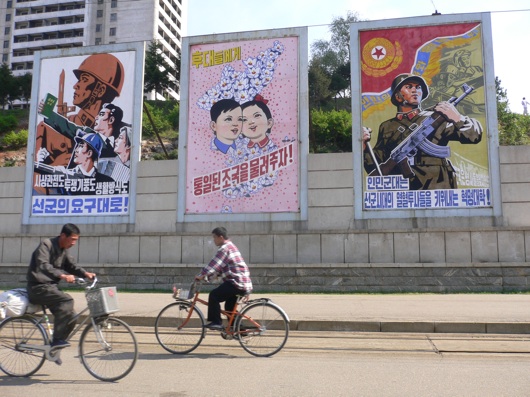 Perhaps somewhat surprisingly, it is a country that values and encourages its artists, however, their creative expression is not their own but that of the now late “Dear Leader”. We visited a studio of artists, all of whom were considered the most skilled and talented in North Korea, and met a woman, Kim Sung Hui, who was painting what was required of her by the regime, but also her own works.
Perhaps somewhat surprisingly, it is a country that values and encourages its artists, however, their creative expression is not their own but that of the now late “Dear Leader”. We visited a studio of artists, all of whom were considered the most skilled and talented in North Korea, and met a woman, Kim Sung Hui, who was painting what was required of her by the regime, but also her own works.
She was tightly controlled, and everything she produced was approved. But her paintings were identifiably her own. In a country so dedicated to eradicating individualism, originality still managed to emerge through the canvases she and the others painted. I am not suggesting that any of the artists were attempting to make any particular statements or stand against the regime. But it made us think that rebellion and insubordination can be found, not just in obvious acts of opposition, but also through the creation of art that reflects one’s own individualism and personality. In the subtle portrayal of life as seen by one person. In incremental changes from what is expected.
All movements in the history of art started like this. And all progression in the rights of women, and indeed humanity generally need to start with one little step, one brush of paint, one small act of creativity.
Joanna Francis spends most of her time hanging out with her one year old son. But she also works for a children’s foundation and has recently started her own little business making baby quilts. Her house is a mess. In the past, Joanna has worked as an aid worker in several developing countries, and is passionate about the rights of women and children. You can visit her and her blog at www.miettehandmade.com
Scenes From Sydney: April Action
By Jaclyn Carlson The month of April always seems to fly by and before you know it, May has arrived and you find yourself wondering how quickly the year is going by. April in particular is always full of action, the days are shorter and your social calendar seems to fill up with launches, gallery openings, dinners and other winter gatherings. It's time to embrace April and all her creative options so get out there, get active and don't miss these three Sydney highlights...
MCA Sydney's Museum of Contemporary Art has finally re-opened with an impressive launch collection of new exhibits and has brought back late night Thursdays, for the after work crowd wanting their visual fix.
7 Kinds of Happiness: Conversations on Design and Emotion Part of DesignEx, this three day program involves a series of 7 seminars run by speakers such as Alice Rawsthorne and Stefan Sagmeister all exploring the question, 'can designers create happiness?' What's even more interesting is that the seminars themselves will be held inside a structure made entirely of doonas.
AGDA Presents: Substance Is The New Style The NSW branch of the AGDA presents a night exploring strategic design thinking and examining how design thinking has been employed across the globe to deliver innovative solutions that change industry standards and redefine market positions.
Events about art, happiness and style? Sounds like an action packed and pretty awesome end to April...
Originally from Boston, Massachusetts, Jaclyn Carlson is the author behind the Sydney-based blog, Little Paper Trees. When not documenting her expat adventures, she can be found working for one of Australia’s top design & homewares trade shows. Passionate and prone to wasting hours on Pinterest, she has years of experience in marketing, advertising and PR and aims to put Sydney’s creative women in the spotlight with her monthly column.
Tools of the Trade: The Adventures of Flo
By Brianna Read Meet Florence, or Flo as she is affectionately known, the hard working heart of Frankie & Swiss a Melbourne based boutique textile company.
Frankie & Swiss, the brain child of sisters Michelle Francis and Jacqui Swies, came to possess Florence after two years of research and self-education on the topic of digital fabric printing. This research journey began after Michelle found herself creating an apron of her own design but no matter where she looked, she was simply unable to find the right fabric. This in turn led to experimenting with using a home inkjet printer to make her own design prints, which of course led to the inevitable ‘but I needed something bigger’ conundrum! Enter Florence…as printers go they don’t get much bigger than Flo.
Florence is essentially an enormous inkjet printer. Her particular specialty is printing using water-based pigment inks onto natural fibres. Florence is situated in a wonderful studio space in South Yarra and both Michelle and Jacqui bring their young children to work with them, so having healthy and safe working materials was of paramount concern for the sisters. The choice of equipment and materials for Frankie & Swiss is navigated by exceptional standards of practicality, ethics and style.
Though her sheer size implies she may be able to do it all, Florence certainly doesn’t work alone. The support systems behind Florence are also what make these beautiful designs possible. Artwork comes to Florence in digital format, the team make any tweaks or changes necessary in Photoshop and the artwork is imported into Florence’s own software where the final formatting and repeat systems are set up. From here the focus shifts to monitoring the fabrics Florence creates. Working with natural fibres means regular evaluation or ‘fabric profiling’ is needed throughout the printing process to ensure the highest quality print is achieved.
 After Florence finishes printing the fabric lengths, they are then fed back through the machine to be heat set. From here the fabric is ready for use. The absence of pre and post-treatments of the fabric was another choice made to avoid unnecessary waste and chemical intervention. These fabrics are a wonderful union of old fashioned values and cutting edge technology.
Frankie & Swiss (and Florence) have worked with some extraordinary talent: Penny Durston of Cottage Industries, Shelly Panton and NancyBird to name a few, helping them produce fine fabrics to specification. This collaborative approach to business shines again in the soon to be launched Leaf Series, working with artists Kelly Smith, Dawn Tan, Kat Chadwick and Rowena Martinich amongst others to create some seriously lust-worthy prints.
After Florence finishes printing the fabric lengths, they are then fed back through the machine to be heat set. From here the fabric is ready for use. The absence of pre and post-treatments of the fabric was another choice made to avoid unnecessary waste and chemical intervention. These fabrics are a wonderful union of old fashioned values and cutting edge technology.
Frankie & Swiss (and Florence) have worked with some extraordinary talent: Penny Durston of Cottage Industries, Shelly Panton and NancyBird to name a few, helping them produce fine fabrics to specification. This collaborative approach to business shines again in the soon to be launched Leaf Series, working with artists Kelly Smith, Dawn Tan, Kat Chadwick and Rowena Martinich amongst others to create some seriously lust-worthy prints.
When I ask Michelle why they chose to name their machine Florence she explains the name is a nod to another creative woman: Florence Broadhurst, while also being a quirky pun on what Florence actually does: a reference to the 'flow' of ink from machine to fabric. She continues on to explain that after leaving a corporate career in favour of the creative adventure that is Frankie & Swiss she wanted to keep the fun in business – Florence may look serious, but with these sisters at the helm the fabric she produces are certainly all about fun.
Brianna Read is a designer-maker based in Melbourne. Her knitwear label Jack of Diamonds Knits employs hand-made techniques in combination with machine knit technologies. Brianna’s multi-faceted creative practice encompasses design, production, works for exhibition and machine knitting workshops.
Organise Me: Top 5 Productivity Tips
Productivity - noun 1. The state or quality of producing something. 2. The effectiveness of productive effort, as measured in terms of the rate of output per unit of input.
Like most creatives you are probably so busy that time passes you by and you wonder where all of your time went. Or you may find yourself constantly sacrificing your personal life in order to stay on top of your work commitments. At the same time you are probably questioning how others manage to stay productive, and why it looks so easy to those organised folk.
It turns out that setting goals, effective time management and discipline are key to giving yourself more quality time. Recently, I broke the silence and asked two busy creatives (who are as equally organised as they are busy) what their secret is to being and staying productive in their professional lives.
Meet the creatives: Jen Clark, Melbourne A design director and owner of Melbourne design studio Jen Clark Design, Jen Clark has over 15 years experience in all aspects of graphic design, specialising in branding and web design for new and existing businesses. @JenClarkDesign www.jenclarkdesign.com.au
Tanya Ruxton, Sydney A creative type with over 12yrs experience, working as the Head of Teaching, Shillington College, Australia. With a love for organisation, Tanya has run many creative side projects in her spare time, as well as her own graphic design business. @wearemessengers http://wearemessengers.com
Several tips reappeared in Jen and Tanya's answers - these tips appear to be the most universally recognised and most commonly adopted between organised folk. Following are their combined all time top 5 tips for productivity.
1. To-do Lists Manage tasks by keeping and writing lists. Andy's tip: Complete basic tasks as they arise. Jen's tip: The best time to make a list is often when you have the least time to write one. Tan's tip: Write a new list every day or every second day to keep on track.
2. Schedule blocks of time Plan your day in "blocks" (much like Hugh Grant in "About a Boy"). Plan ahead whenever possible by mapping out project deadlines for the following weeks or months ahead. Andy's tip: Keep an up to date calendar. Jen's tip: Set mini-deadlines throughout the day. Tan's tip: Be committed and don't get distracted.
3. Working space Create a comfortable working environment that you enjoy being in and that inspires you. This includes getting dressed as if you were heading to the office if you work from home. Andy's tip: Ergonomics work. Jen's tip: Your space influences your work, it can invoke feelings of vitality, energy and motivation. Tan's tip: Be comfortable, invest in a good chair. Declutter - tidy desk, tidy day.
4. Be realistic Secretly thinking we are Superwoman and can do it all doesn't always work. When opportunities arise communicate your current commitments and capabilities to clients. This will ensure you are not overbooking yourself or feeling overstretched or compromised on time. Andy's tip: You can not always say yes. Jen's tip: Be honest. Tan's tip: Don't over promise. Get a freelancer to help out.
5. Take breaks: When you work solo it can be very easy to work right through the day and night. However by establishing a routine and taking breaks you'll be less likely to procrastinate and find you are more reinvigorated to continue. Seriously taking a break can refresh your mind, your soul and your eyes. Andy's tip: Routine - 10am coffee, 12.30 lunch, 3pm stretch. Jen's tip: Time away from the desk is important. Don't get caught up in the lure of the immediate. Tan's tip: Enjoy your lunch break.
A big thankyou to Jen and Tanya for their sharing their top productivity tips (there are more to come). Now that we have demystified some of those efficient working habits we are a step closer to becoming one of those elusive, productive, organised folk.
Andrea McArthur has a passion for all things visual and a soft spot for organisation. Type is her true love and goes weak at the knees over beautiful design. Andrea works as a freelance graphic designer in Brisbane by day and lectures in graphic design by night. You will find her sharing design related goodness via @andyjane_mc




